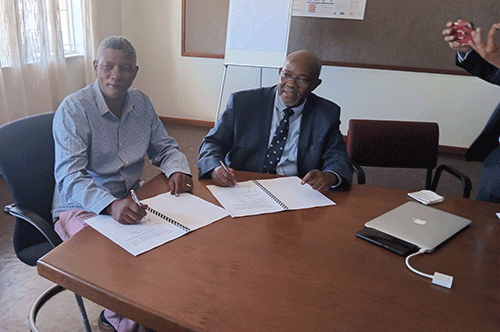KEETMANSHOOP – Members of the !Gawachab conservancy in the //Kharas region on Wednesday signed an agreement for the establishment of a 1.620 Mega Watt (MW) renewable energy park.
The US$1.6 billion (over N$29 billion) agreement with Ikhaya Somandla Family (ISF) Trading Enterprises was signed in Keetmanshoop.
In her keynote address,
//Kharas governor Aletha Frederick said the project is one of the bold strides undertaken in shaping the energy sector, especially with regard to intensifying efforts of scaling up the production of renewable energy and curbing the effects of climate change.
She said, to facilitate clean energy trade in the SADC region, governments should work together to establish the most needed regulatory frameworks and infrastructure. Frederick also said as a regional government, they are deeply pleased to be part of the establishment of the !Gawachab Solar Park Project.
“This will assist us in addressing the green economy value chain to create employment and alleviate poverty.”
She emphasised that the building of sustainable, vibrant communities is also one of the goals within the context of the regional government’s developmental agenda, and, therefore, //Kharas have a great appreciation that the !Gawachab conservancy community development activities are incorporated into this initiative. Commending ISF Trading Enterprises, she said the team’s commitment to the development of accredited training programmes in Namibia with the express purpose of transferring knowledge and expertise to contribute to developing the local solar industry is commendable.
“This will assist us to close the skills gap along the clean energy value chain,” she added. Frederick, on behalf of the regional council, extended her deep gratitude to all the role players who have contributed to this milestone achievement towards the success of this project.
In his contribution, Johannes Markus, chairperson of the !Gawachab conservancy said their area is ideal and have the needed capacity for the generation of solar energy. “We are fortunate to have the sun shining most times of the day with high temperatures,” he added. Markus continued that the 13 000ha conservancy, in addition also have great potential for agricultural projects as it is situated only eight kilometres from the second biggest catchment dam in the country, the Naute Dam.
“With massive projects like this, we will now be able to overcome the hurdles and challenges experienced and also benefit to the fullest from this initiative,” he said. The chairperson, on behalf of the conservancy also expressed their profound gratitude and appreciation towards Ikhaya Somandla Family Trading Enterprises for identifying the conservancy as the most suitable area for the envisaged project.
James Links, the chief steward for ISF said they regard the project as one worth working on and for the benefit of future generations.
“We proposed a 120KW plant, but based on the capacity, the designated area has to generate renewable solar energy, the captains of industries raised the bar with another 1 500MW,” he explained. Links continued that they deemed it fit to invest US$1.6 billion in the solar energy plant, being offered 2 500ha of land by a robust management team saying, “we want it now!”
“Once operational, we will share access power with the national grid and also the Southern African Power Pool, provided we have enough solar energy left after own consumption,” he explained.
In terms of the entity’s social corporate responsibility of ploughing back into the conservancy’s community, he explained that they will establish new townships with the aim of luring those people who left for a better life back home.
“We will also pay over 5% of all profits made once operational to the conservancy’s management committee,” he added. Links continued that 25% of all goods, materials and services needed will be sourced locally whilst employment opportunities will be created accordingly. He also said much concentration will also be put into the area of skills transfer, in order to empower the members.
According to Links, after the signing of the agreement, the conservancy will receive a monthly lease amount for the land of N$40 000, which will increase by 2% annually. An environmental impact assessment will first be carried out while predictions are that operations to construct the plant will commence during 2026. The project will be funded by Angolan investors and the European Investment Bank in Lisbon while technical services will also be provided by various foreign and local companies.
The project will have a lifespan of 30 years.
– sklukowski@nepc.com.na


